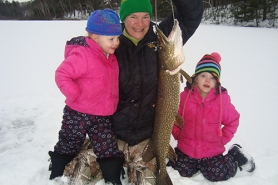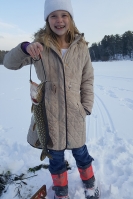Tips to make ice fishing fun for the whole family
Pamela and Scott Toshner are avid ice anglers and parents of twin girls. The couple – she is a DNR lake and watershed protection specialist and he is a DNR fisheries supervisor -- started getting the girls involved in fishing when they were about 3 years old. The first couple of years were short trips and by 5 years old, the girls were already fairly seasoned ice anglers.
Here are the Toshners’ tips for ice fishing fun with the whole family.
Tips to make ice fishing fun for the whole family
Getting ready for adventure:
- Go into the adventure with an open and patient mindset.
- We have had success starting out with tip-up fishing in spots that have good action. Northern pike are usually what we catch and make a great fish to start kids on. Try to get them involved in the whole process. For instance, take them to the bait shop to pick up minnows, snacks and refreshments. Let them help with scooping the slush out of holes and catching minnows out of the bait bucket.
- Make sure they're dressed for the weather. Let them go inside a vehicle, shack or house to warm up when they get cold.
- Bring food, snacks and beverages for them - but have a plan on how to take care of bathroom needs. A bucket and maybe a blanket to hold up to provide some privacy can work if you’re fishing in a busy area.
- Fishing with tip-ups is usually more successful than asking kids to sit on a bucket watching a hole. With tip-ups, they don't have to sit in one place and watch for a bobber to go down. However, if you have a good action lake for panfish and either a warm winter day or an ice shack, jigging is fun as well.
- Have other activities for them to do while waiting for a flag to go up. Our girls like ice skating, cross country skiing and sledding. They play tic-tac-toe in the snow and shuffle ice path mazes with their feet followed by a game of tag in the maze. Veer outside the path, and you’re out! Bringing our dog along also provides them with some entertainment.
When they catch a fish
- Let them catch the fish. If more than one child is along, figure out a system of taking turns before the first flag goes up. We often flip a coin for who goes first. The other child's turn begins after the first has actually caught a fish and not just run to a flag to find no fish or after losing a fish.
- Be ready for some tears when a fish is lost at the hole. It happens and is a bit of a life lesson. We personally try not to give too much instruction on how to land a fish, they figure it out pretty quickly.
- Make a big deal about any fish they do catch -- any size or any species. To a kid, a skinny 22-inch northern pike is a bigger fish than a nice chunky 19-inch walleye.
- Have a camera or your phone along - it makes a kid proud to get his or her picture taken with a fish. Again, any size or species of fish will do. With today's smartphones, you can also take video footage of the kids catching the fish.
- We usually bring a fillet knife and cutting board along, which enables us to fillet the fish out on the ice. The kids love watching and always ask to cut the fish’s stomach open to see what it has been eating.
- Take it from the ice to the dinner table. The kids are proud to provide a meal for the family, so make sure they are involved in the process. (Quick tip: for northern pike up to about 26 inches in length we simply fillet the fish with the bones in it and put it through the meat grinder…. bones included and unnoticeable in the final product. We then add bread crumbs and seasoning, an egg or two and mix. Make some patties and fry them in a pan for a delicious dinner.)
- Take the opportunity to teach them a bit about fish and fish habitat. The questions of why we are fishing here and not there are the basis for them learning about fisheries habitat and ecology. For example, we fish for northern pike in bays with aquatic plants because those are the habitats that allow pike to feed and seek cover. Without the aquatic plant habitat, the fish may not be there for us to catch.
- This one may be the hardest for hardcore adult ice anglers…….be ready to leave when the kids are no longer having fun. Sometimes the bite isn’t good or even if it is they just get tired of it. Especially for younger kids, two hours is plenty of time on the ice. Although “prime time” may be coming up, if the kids aren’t having fun they are less likely to want to go again.
- Let them bring their friends. Not only will this make for more fun when the fish aren’t biting, but you may introduce someone to the sport who otherwise might not get the opportunity.



